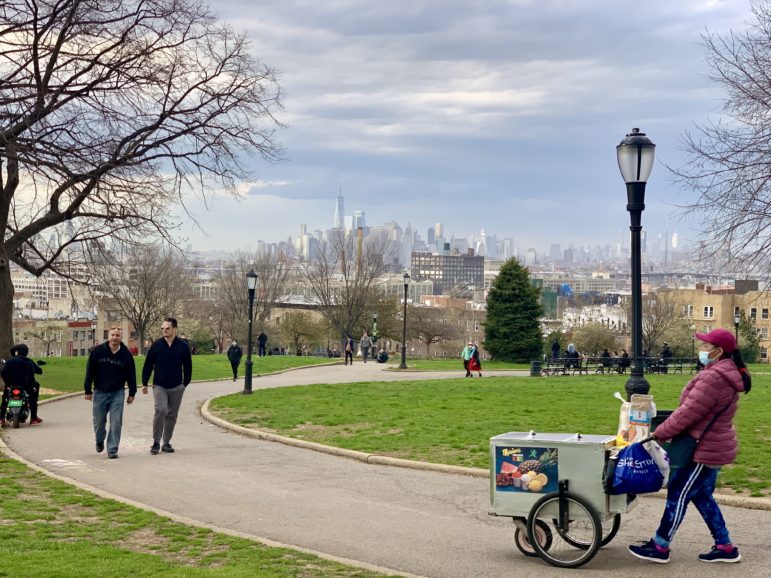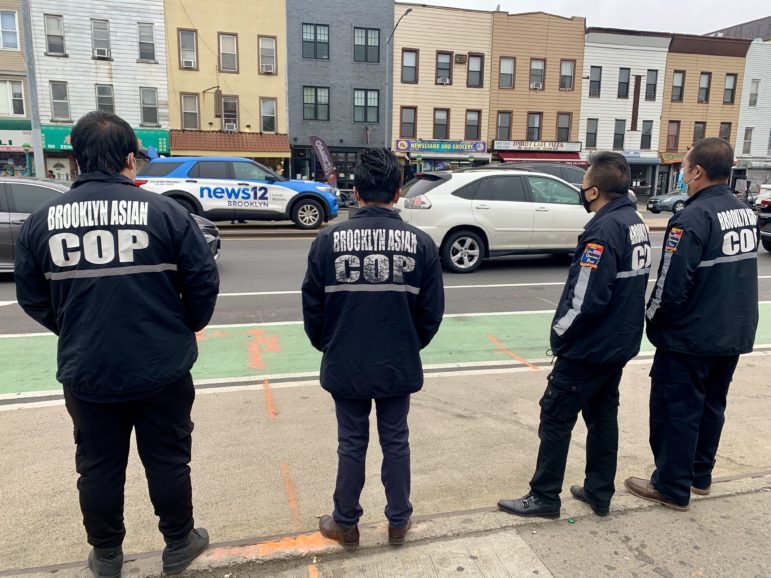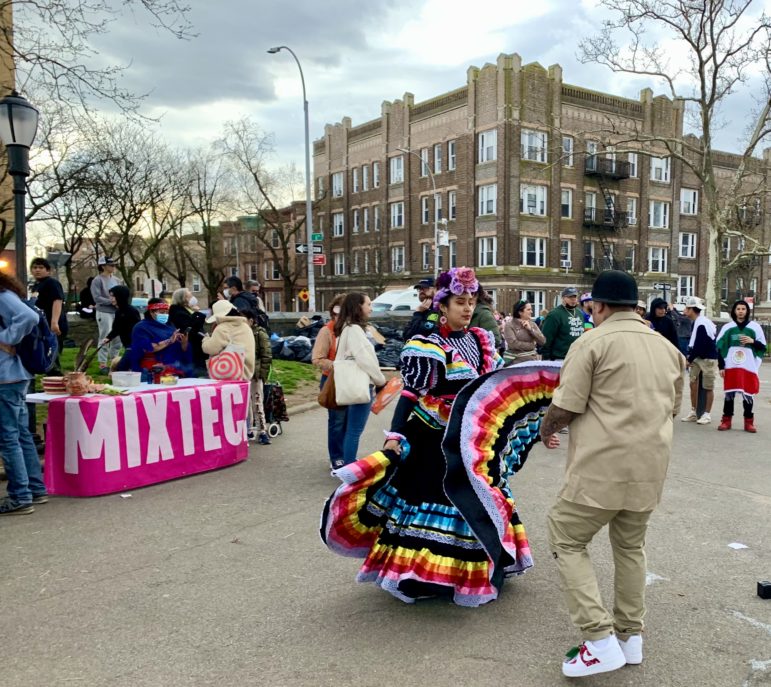Some in Sunset Park worry their experience of random violence will invoke a response more focused on carceral measures than addressing structural inequalities that shape public safety. “When I think about safety here, I think of how we need stimulus relief bills, unemployment and healthcare,” one local resident told City Limits. “Not police.”

Mary Steffenhagen
A view of Manhattan from Sunset Park on April 16, 2022.The day after Frank James opened fire on the N train in Sunset Park, injuring at least 23 people, resident Whitney Hu met a group of friends in the eponymous neighborhood park to decompress—the place where she feels most grounded, she told City Limits.
But the atmosphere became tense, she said, when two NYPD officers entered the green and issued tickets to a few delivery workers for having alcohol in the park. There were plenty of others around them with open containers, but the cops focused on the Latino men, Hu said. The incident illustrates why she believes more police will not mean more public safety.
“Policing hasn’t always meant community safety for us,” Hu said.
In the wake of the shooting, Mayor Eric Adams has proposed doubling the number of cops patrolling subways and installing metal detectors in stations, while continuing his plan to evict unhoused people from trains and other public spaces. But some in Sunset Park worry their experience of random violence will invoke a response more focused on carceral measures than addressing structural inequalities that shape public safety—particularly for a neighborhood where nearly half of the population is foreign-born, and where the poverty rate slightly exceeds the citywide average.
Jorge Muniz-Reyes, a neighborhood resident, said, “When I think about safety here, I think of how we need stimulus relief bills, unemployment and healthcare. Not police.”
Many Latino, Arab and Asian families call Sunset Park home—a “mosaic,” as a few of them put it—and they have a long history of stepping up to support each other in the face of institutional failures and exclusion. The neighborhood is home to the South Brooklyn Mutual Aid group, which has raised over $400,000 since the pandemic began for meals and supplies, and The Workers Justice Project, which has been integral in the fight for the Excluded Workers Fund for economic relief for low-income workers.
Neighbors successfully fought off a rezoning proposal that some experts said would “supercharge” gentrification. Many residents here are immigrants, and raids by ICE are still fresh in the neighborhood’s memory.
“When I see a group of police officers in the subway train, I automatically feel nervous. Like I may be stopped by them for wearing a backpack or for looking at them wrong or for being too close to them,” said Rodrigo Camarena, an immigrant rights advocate who ran for the local City Council seat last year. He said many of his undocumented neighbors worry that one interaction with the police could result in their deportation.

Mary Steffenhagen
The 36th Street subway station in Sunset Park, where a man opened fire on passengers on April 12.But the mosaic of the neighborhood is also reflected in its residents’ perspectives on the NYPD’s role in public safety.
Abel Pepin Placencio, a college student and 13-year resident of Sunset Park by way of the Dominican Republic, had his own experience with police harassment as a teen, saying he was stopped by an officer who mistook his red, white and blue necklace from the D.R. as a gang symbol. But a few years later, he joined the Law Enforcement Explorers summer program, which gives high schoolers an introduction to careers in the NYPD.
“I wanted to know what kind of people are in my local precinct,” he explained. “Before that I didn’t have such a good outlook on them but [the program] opened my eyes to the NYPD, in terms of—these guys are not as bad as I thought they were.”
Placencio now believes that more police and their visible presence makes neighborhoods safer, and others share his perspective. Denny Chen, the vice president of the 72nd Precinct Community Council—a group of volunteers serving as liaisons between communities and police—said he’s hoping to see more patrols in the subways in the coming days.
The number of officers regularly assigned to the 72nd Precinct has remained steady, around 160-170 for the past few years, and Deputy Inspector Ernesto Castro told City Limits he is not aware of any plans for change. The NYPD did not respond to a request for comment on staffing levels at the station house, which is located just a handful of blocks from where this month’s shooting took place.
NYPD Comp Stat data for the 72nd Precinct shows major crime numbers increased from 276 incidents this time last year to 564 today, or a 104 percent uptick. But in the past four weeks, the numbers have been trending downward, D.I. Castro stated.

Mary Steffenhagen
Members of Brooklyn Asian COP, a civilian neighborhood watch team endorsed by the NYPD, attend a vigil against gun violence at the 36th Street subway station on April 18, 2022.At a recent meeting of the 72nd Precinct Community Council, a week after the subway attack, it was business as usual. Residents raised concerns about e-bikes blocking sidewalks, delivery trucks causing traffic, and marijuana smoke in the streets. D.I. Castro noted that the precinct has been increasing the number of summonses issued for “quality of life” offenses over the past four weeks—such as public drinking, as Hu says she witnessed in the park.
This kind of policing strikes those like Hu and Camarena as mainly cosmetic. It didn’t prevent the subway attack, Camarena pointed out, nor did surveillance cameras or increased police patrols.
“The events of last Tuesday were really an anomaly,” Camarena said. “What is preventable are the things that we see on a day to day basis: folks without homes sleeping on subways, in need of mental health assistance, without jobs or opportunities coming to the subway to ask for money.”
“Those are the kinds of day to day occurrences that we can prevent through policy for supportive housing, jobs, mental health services, healthcare,” he added.
Neighbors and community groups that already worked on these issues have further directed their attention to helping the neighborhood process the subway attack. The Academy of Medical & Public Health Services has been hosting mental health circles over Zoom, and is planning self-defense workshops, executive vice president Mon Yuck Yu told City Limits.
Hu, through South Brooklyn Mutual Aid, is fundraising for injured neighbors, having already raised over $18,000. Local organizations like Mixteca, UPROSE and The Healing Center showed up for a “Day of Unity” in the park last weekend.
Many residents told City Limits that the shooting hasn’t changed how they feel about their neighborhood and their general safety here.
“I’m not afraid,” said Roberta Cordeau, a teacher at P.S. 516. “This is my home.”
Even Placino, who wants to see more cops, feels the neighborhood is much safer than others in Brooklyn. “I’m more alert in the subway [now],” he said. “But it doesn’t affect my view of the neighborhood at all. Crime is low.”

Mary Steffenhagen
Sunset Park neighbors and organizations gathered at the park on April 16, 2022 for a “Day of Unity” following the shooting.
For Hu, who briefly ran for the district’s City Council seat in 2020, Sunset Park has always been a safe haven, and it still is. “Once you live in Sunset Park, you become diehard about this neighborhood,” she said.
But she wants the rest of the city to understand that what makes Sunset Park great—its multicultural people, small businesses and restaurants, and strong sense of community—aren’t things that are necessarily protected by policing, but by policies that address rising rent, low wages and other inequalities.
“Everyone wants to come here for Chinatown, for the tacos on Fifth Avenue. But do they understand that those businesses on Eighth Avenue might not be around very much longer if they can’t afford to stay in the neighborhood?” she said. “You want to come here, but are you fighting for the things that would actually support and help my community?”








2 thoughts on “In Wake of Subway Attack, Sunset Park Grapples With What Public Safety Should Look Like”
You reach out to and lead with three radical poster children – 2 of whom sought the socialist endorsement – and thinks that reflects the will of the community?
Average working class immigrants, homeowners, business owners, etc in the area want safe streets and more police and reversal of disastrous policies like bail reform. Apart from the Pew polls that clearly show this (especially true in communities of color), living in Sunset park and talking to people my entire life tells me this, too. Of course activist ideologues will say otherwise, but they are not representative of those in the neighborhood tired of violence, shootings, stabbings, robberies, assaults, blatant package theft/drug dealing/drug use, encampments of people high and drunk harrassing passerbys in our park and on our avenues…
Unfortunately in our neighborhood, those with the loudest voices on twitter lead people to believe they speak for our community. They in fact do not.
MEMO TO CITY LIMITS.ORG
I invite City Limits to give coverage to the issue of Asian Businesses hiring practices.
There are about 16,000 Asian-owned businesses in New York City about 77 percent of which are actually located in Black and Brown neighborhoods. Do the math: 77% of 16,000.
These Asian-owned businesses are laundry mats, nail salons, hair salons, fish stores, the so-called 99 cents variety stores and restaurants–and they make untold sums of money which these Asian businesses in turn take out of the Black and Brown neighborhoods. The result is huge amounts of anger by Black folks directed at the Asian Community. Under NO circumstances am I justifying criminal assaults by anyone against anyone–I am merely explaining the WHY of this issue.
There must be some serious journalistic investigations into what on the face of it is a full-scale boycott against the Black Community by the Asian business community. Nary a single city, state or federal elected public official in New York City will touch this issue. What’s more the self-appointed Civil Rights “Leaders” and Advocates also have failed to date to touch this issue.
City Limits, can you hear the cries of New York City’s Black and Brown Community?